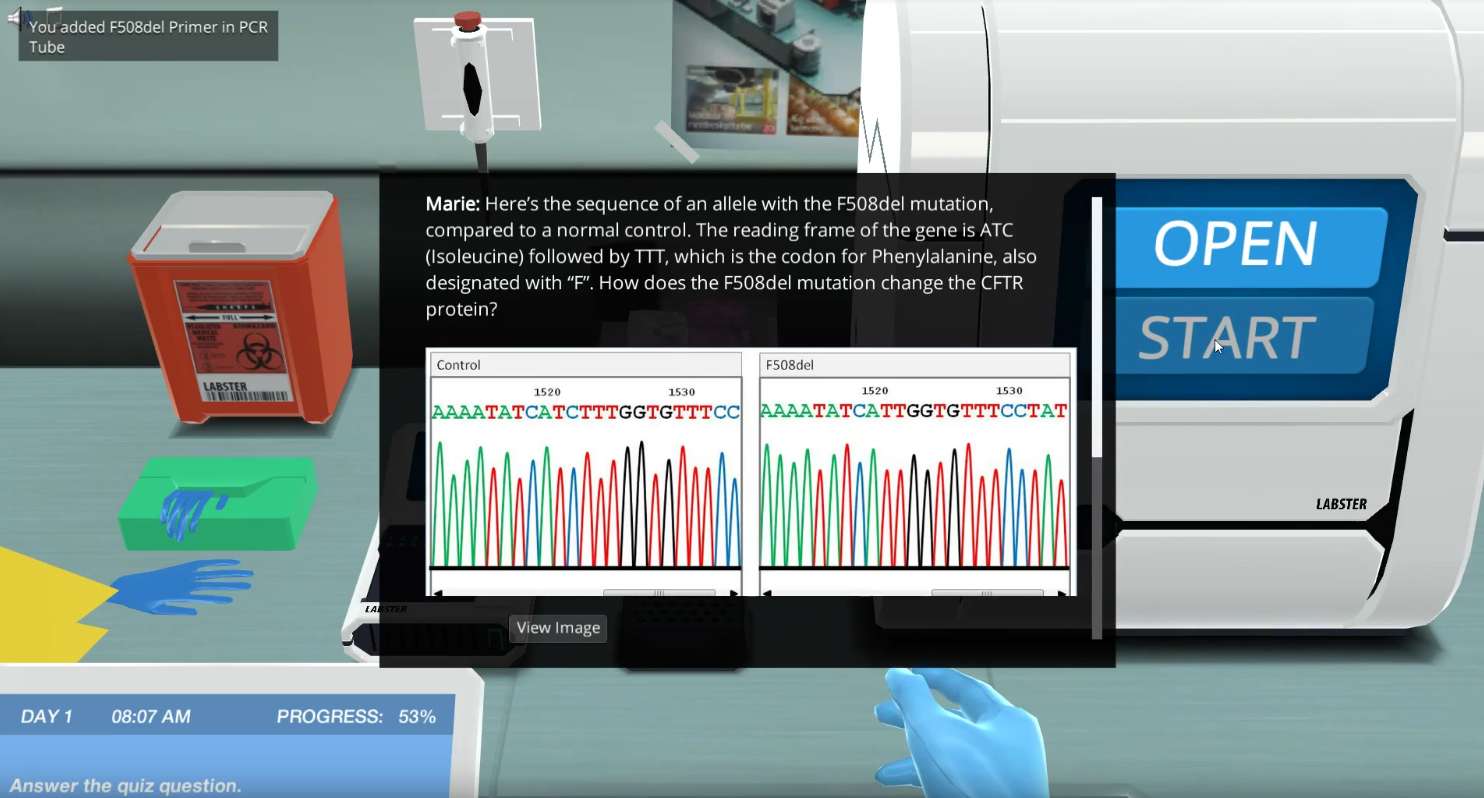Heading 1
Heading 2
Heading 3
Heading 4
Heading 5
Heading 6
Lorem ipsum dolor sit amet, consectetur adipiscing elit, sed do eiusmod tempor incididunt ut labore et dolore magna aliqua. Ut enim ad minim veniam, quis nostrud exercitation ullamco laboris nisi ut aliquip ex ea commodo consequat. Duis aute irure dolor in reprehenderit in voluptate velit esse cillum dolore eu fugiat nulla pariatur.
Block quote
Ordered list
- Item 1
- Item 2
- Item 3
Unordered list
- Item A
- Item B
- Item C
Bold text
Emphasis
Superscript
Subscript
About This Simulation
Learn about the monogenic disorder Cystic Fibrosis and its inheritance from one generation to the next.
Learning Objectives
- Understand the basic concepts of inheritance
- Build and interpret a pedigree based on family data
- Understand genetic risk assessment and counselling
- Understand the work of a genetics laboratory
About This Simulation
Lab Techniques
- Gel electrophoresis
- Capillary electrophoresis
- PCR
Related Standards
- HS-LS3-1
- HS-LS3-2
- HS-LS3-3
- No direct alignment
- 3.4 Inheritance
Learn More About This Simulation
Cystic Fibrosis is a type of monogenic disorder caused by a mutation in both copies of the CFTR gene (Cystic Fibrosis Transmembrane Conductance Regulator).
Learn about Cystic Fibrosis
The CTFR gene encodes a protein that regulates the movement of chloride ions in and out of cells that produce mucus, sweat, saliva, or tears. Cystic Fibrosis is also called mucoviscidosis because patients suffer from thickened mucus. People with one mutated copy of the CFTR gene are called carriers and do not experience any symptoms.
Patients with Cystic Fibrosis
Cystic Fibrosis is the most common autosomal recessive disease among Europeans. It is characterized by allele heterogeneity, meaning that CFTR genes from many different patients with Cystic Fibrosis show different type of mutations. The most common alteration in the CFTR gene is a deletion of three nucleotides, resulting in a loss of the amino acid phenylalanine (F) at position 508 in the protein, and is hence called ΔF508.
Apply your knowledge
In the Monogenic Disorders lab, you will learn about the monogenic disorder Cystic Fibrosis and its inheritance from one generation to the next. You will also learn how a single gene mutation leads to a dysfunctional, disease-causing protein.
Will you be able to consult a young couple on the potential risk for their future children to develop Cystic Fibrosis?
Experience Labster for Yourself
Boost Learning with Fun
75% of students show high engagement and improved grades with Labster
Discover Simulations That Match Your Syllabus
Easily bolster your learning objectives with relevant, interactive content
Place Students in the Shoes of Real Scientists
Practice a lab procedure or visualize theory through narrative-driven scenarios


For Science Programs Providing a Learning Advantage
FAQs
Find answers to frequently asked questions.
Heading 1
Heading 2
Heading 3
Heading 4
Heading 5
Heading 6
Lorem ipsum dolor sit amet, consectetur adipiscing elit, sed do eiusmod tempor incididunt ut labore et dolore magna aliqua. Ut enim ad minim veniam, quis nostrud exercitation ullamco laboris nisi ut aliquip ex ea commodo consequat. Duis aute irure dolor in reprehenderit in voluptate velit esse cillum dolore eu fugiat nulla pariatur.
Block quote
Ordered list
- Item 1
- Item 2
- Item 3
Unordered list
- Item A
- Item B
- Item C
Bold text
Emphasis
Superscript
Subscript
Labster can be integrated within a school's LMS (Learning Management System), and students can access it like any other assignment in their LMS. If your Institution does not choose an LMS integration, students will log in to Labster's Course Manager once they have an account created. Your institution will decide the access method during the sales process.
Labster is only available for purchase by faculty and administration at academic institutions. To procure Labster, simply reach out to us on our website. Schedule a demo, book a meeting to discuss pricing, start a free trial, or simply fill out our contact form.
Labster simulations are created by real scientists and designed with unparalleled interactivity. Unlike point and click competitors, Labster simulations immerse students and encourage mastery through active learning.
Labster supports a wide range of courses at the high school and university level across fields in biology, chemistry and physics. Some simulations mimic lab procedures with high fidelity to train foundational skills, while others are meant to bring theory to life through interactive scenarios.


















